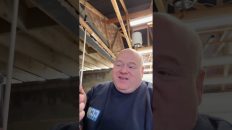How to power flush a system better. My name’s Alan Hart and in today’s video, I’ve got a special guest today. I’ve got Steven from the Power Flush Association and he’s thousands and thousands of power flush jobs. And Steven is going to give us some tips on power flushing and some of the things that he does. So hopefully this video should be really, really helpful for you if you’re a trainee and you’re going to be getting into doing power flushing, then as I say, hopefully this will be really good. Some really good tips in this video. If you could please put a thumbs up on the video, it really helps with the videos. We put a lot of time and effort into doing these videos for you. And also if you could put a comment below, even if you just put power flush, or if you’ve asked some questions below and we’ll try and answer them for you as well. So let’s go over to Steven.
Thank you, Alan. My name is Steven and I started the Power Flush Association. The reason I started the association is because there’s not a lot of information written online about the real experience and the practicalities of cleaning central heating systems, written by experienced engineers. I myself have cleaned several thousand systems and I find that there is five variables that really matter.
So no system can be cleaned 100%. It’s a theoretical ideal. The closest you’re going to get to that is in the high nineties. And how you do that depends, in my opinion, on these five factors. So heating the system is important, in combination with using chemicals. The filtering out of the rust and the non-magnetic debris is also important. Flow is extremely important. And how you connect into the system makes a big difference to how close you will get to this hundred percent.
The first variable I’m going to discuss is heat. It’s important to heat the system when you’re power flushing it or cleaning it by any means, if at all possible. The more you heat it, the softer the rust becomes and the more it structurally breaks down. So if you had a block, the more you can heat that block, the more likely it is for that block to break down and for the rust to be kicked out, back to your machine. Now, when you’re power flushing a system, it’s kind of hard to have the boilers on. On sealed systems, especially. Open vented you can normally get away with it, running your machine at the same time. On sealed systems because you’ve dropped the pressure, they don’t always want to work.
One of the tips I would say is to connect in a way where you can seal off your machine. So that you can pressurise the system, run it hot, and then open your connections back into your machine. So that you can then flush it when it’s hot. And you can do that every time you want to heat it. And there’s also power flush machines with heater packs built on. And there’s also heater packs that you can buy and connect into your hoses. So there are many ways that you can heat the system up. There’s no specific temperature. Any heat is good, but the more heat, the better. So your success rate would be higher if you used more heat for longer.
Another variable to consider is chemicals. So chemicals are important because it helps break down the rust in the system. It’s important to understand that it doesn’t make the rust disappear. It just breaks it down in the system. The longer you give the chemical to work, the better it’ll break it down. And the higher temperature you can make it work at, will break it down better as well. A top tip is to put it in a week before, if the manufacturer allows it. Because some chemicals shouldn’t be in systems that long. But it gives the chemical time to work, to be heated up, to work around the system, to soften the rust so that when you come along and do the power flush, it’s already been broken down and your power flush can be done much quicker.
So there are different manufacturers for chemicals. Each one has different systems you can use it on, and different recommendations to how long it can be in the system or what it should be used for. I would recommend that you try them all and see what works best for you. Always try and put a little bit more in than the manufacturer says is the minimum. The more chemicals you have, the better results you’re going to get, combined with heat and time.
Another variable to keep in mind is the flow rate. So when you have a power flush machine, irrespective of its brand, it will have a set maximum flow rate. So when you connect it onto the system, when you use it in a system, you need to try and maximise that flow rate and not hold the machine back. The best ways to do that is to focus it down to the areas you want to clean. So if you have 10 radiators, close nine of them, close the radiator and focus all your flow through just one radiator.
Remember that rust is heavy and that it does not want to lift up and come out. You need to try and disturb it. And using the most flow you possibly can is very good way to do it. A top tip for cleaning a radiator, especially the longer ones which will have lower flow rates in the middle, where the rust is settled, is to have a TRV valve where you take the head off and you bounce it in the flow rate. And that shock and change in flow disturbs the rust. And it tends to clean better than to not do this.
The most important variable in power flushing is to have filtering on your system. There’s two main types. There’s magnetic filtering and there’s non-magnetic filtering. So magnetic filtering is the most important one of the two, where a magnet catches the rust and holds onto it so that you can go and clean it out. And it’s removed from circulation and from the system. What people don’t always understand about magnetic rust is that there can be a lot of rust in a system. So three months ago, I cleaned a system with 15 radiators on it and I removed 13.5 kilos of rust from it. So you need to check your magnets regularly, and don’t think that the five radiator system will only be you cleaning the magnets once or twice. It can be a lot more than that. So non-magnetic filtering is overlooked mostly. And people aren’t always aware of it.
So the non-magnetic particles will settle down at the bottom of your filters and of your power flush machine. So it’s a good idea to have a look now and then to see what’s in there and see if you need to clean them out. Where you tend to get non magnetic debris is when you have an open vented system and things fell in the top of the tank. I’ve seen pieces of cement or just sand, the way people have building sand when they change their roof, it fell into the tank and went into the system and blocked it up. And then to remove that is quite difficult because you’re not always looking for the non-magnetic debris. So the top tip there is check your magnets very often, and look in the bottom of the magnets and the power flush machine. If there’s not non magnetic debris.
So one of the overlooked variables is connections. How you connect into the system, where you connect and why. Now I personally recommend that you always try and connect into the flow and return to the boiler. There are several reasons for this. The first one is that you have 22mm pipes, which allows the biggest flow. And sometimes your problems are in the boiler itself. So you are already connected by the boiler, where you can isolate the system off and just flush the boiler.
And the other one is that the debris coming out of the system, it’s easier to get it out of the smaller parts of the system, and then up a bigger pipe to your machine than the other way around. What I do not recommend from experience is to connect onto microbore pipe. The first issue is that the drop in flow from your machine, remember it’s got a set maximum flow rate, is dramatic. So your flow rate goes right down. It’s very hard to disturb the rust, but then the rust coming out is a flake. It’s big, it’s rigid, and there’s thousands of them. They don’t want to go up this pipe and it’s very hard to get them up this pipe.
They don’t always break down and that’s just the magnetite. You do get non-magnetic debris. Like I was mentioning, sometimes you get cement or sand from building works that fell into the system. You can’t always get the debris up these pipes, so it’s better to flush backwards from a 22mm pipe, that’s connected onto the microbore pipes. So that once it comes out of the microbore pipe, it’s going out the 22mm pipe at full flow rate to your machine. And then, if you had to connect into a radiator and I don’t recommend that you always do that because some of the radiators are on the hot water circuit, and sometimes you have one pipe systems where you don’t realise it until you’ve nearly finished the job. You might just think the system is really clean. But in fact, you weren’t cleaning the system at all the whole time.
So if you have to connect into a radiator, I don’t recommend that you connect into the valves. Either the TLV or the lock shield. Because the actual valve will act like a strainer and all the debris will stay on the other side of this. And you won’t get it into your machine and you won’t get it into your filter. So what I recommend is to take the valve out and go straight onto the 15mm pipe below the valve. And that gives you a full bowl connection of 15mm all the way across. And it will allow maximum flow and it’ll allow you to get the biggest debris out from that place.
So I want to show how I would connect into a system. So I would cut into the boiler and put in a 22mm compression T. Then I would have a full bore butterfly valve. And then I would use an all metal camlock connection. And the reason I use these camlock connections is because once you put them on, they simply will not come off. And they very rarely leak. You can put more valves on the pipe above or below so that you can direct flow through the boiler or through the system. And that you can just turn it off as you wish. And that will help you not having to turn the actual boiler isolator valves, because they tend to leak on you. So it’s better to rely on your own valves, than on the system valves.
I want to do some top tips to help everyone out there power flush better and make less mistakes. So to get better results. The first one is that the radiators with the rust in the middle, instead of taking them out completely and washing them outside and putting them back, you can just drain them half way and that forces the flow through the bottom part so that you clean it better.
Where to set up. I find that it’s better to set up in a bathroom, either in a shower or in the bath itself. It allows you to leave the machine unsupervised. If you forget the filling of the machine on, or if you stop the machine and there’s back flow, it’ll just spill into the shower tray or into the bath and it’s not a big deal. Make sure that you cover the bath or the shower tray that if your machine is rubbing on it, that it doesn’t scratch it. But I find that it’s either in the don’t have floors that you’re going to damage, that’s not expensive or anything like that. That’s not waterproof.
Boiler filter. A lot of boilers have a filter actually on the boiler. It’s a strainer and it’s built into the isolation valves or very near the isolation valves on the boiler. And it’s always worth checking if it has it and if it is blocked. And if you want to power flush that boiler, it’s better to remove them, power flush it, and then put that filter back. Otherwise it’ll just act like a strainer, like it should. And it will just keep the the rust in the system.
Then hoses, I use high pressure hoses and my hoses are much longer than you would think. Because I have longer hoses, I can connect further away so I can connect in more ideal places. I could be in a bath on one floor and connecting the floor above or below me. And that that makes it more versatile. And it means I don’t have to take so many risks.
So a very, very good idea is to have a head torch. This is a rechargeable head torch that I bought on Amazon. Because it’s on your head, your hands are free, so you can do work. And because you’ll permanently have light where you’re looking, it saves a lot of hassle. And it allows you to deal with small leaks and things like that much easier. It also means that if there is a leak on the system, because you can check and because it lights it up, the water would glisten. Where normally in low light conditions, you wouldn’t see it. And that happens a lot when you’re changing water and the whole system is cooling down. So all the joints are contracting. And I find that the most common one is on the lock sheet valves, just here where the glad nut is, you start getting a little bit of altered, weeping out. And just tightening that up. But you tend to miss it, if you don’t have a head torch that lights it up.
And obviously it can cause a lot of damage, if you don’t find it in time. Also the hoses, when everything cools down the hose and hose connections sometimes start dripping. So you need to keep an eye on that. And it’s really good to, to light that up. And the last one is to fit a magnetic filter on the system. The most ideal place to put it is on the return to the boiler, because all the rust is made in the central heating system by the radiators. And that will be pumped by the system pump up the return. And then it’ll go through the filter, it’ll get filtered before it starts blocking the system up.
Now, a lot of people would say, why would you fit a magnetic filter on a clean system? And I’m going to remind you that you do not clean a system a hundred percent. It is how close to that ideal you can get. To fit a magnetic filter means that any other rust or debris will get caught and not block anything up. And that means that your client won’t call you back within a few months or even weeks, and say that the system is re blocked. So it stops callbacks, and it stops a lot of hassle and problems.
Thank you very much for that Steven. Some really, really good tips there. As I’ve said before, if you’ve got any questions, please ask them in the comments below. Personally, I’ve also done hundreds and hundreds of jobs power flushing, so I’ve got a lot of experience in power flushing as well. And I can only agree with the tips that Steven has said there. Some really, really good tips for you. So I hope that’s helped. And as I say, put some comments below, put a thumbs up, like, share, all that good stuff, that’d be great. Thank you very much.







